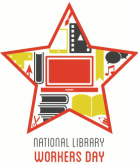
And, not to toot my own horn, but Tuesday is National Library Workers Day!
| Robinson Elementary Library |
|
 Please join me as we celebrate National Library Week, April 14~20. Caroline Kennedy is this year's Honorary Chair. Our very own Mira Costa High School teacher librarian, Mrs. Lofton, got to meet Ms. Kennedy recently as part of her tour as Honorary Chair.
And, not to toot my own horn, but Tuesday is National Library Workers Day!
0 Comments
Two third grade boys looking for books on Destiny and discovering they're lost ...
Boy 1: [sigh] Some people just don't respect books. Boy 2: [nodding] Yeah, I know! Although I lament the fact the books are lost, I couldn't help but smile at their conversation. It warms my heart that there are students who are very protective of books and our library.  Thank you -- goal achieved!
[updated February 7, 2012: People stepped up to calls from across Facebook, Twitter, Google+, and the blogosphere for more signatures. The 25,000 signature threshold was surpassed a couple of days before the February 4 deadline; in the end, 27,093 signatures were collected!] As the school library media specialist, I naturally have an interest in the future of school libraries. I also believe that our school district and the Manhattan Beach Education Foundation feel the same way, and do their best to fund the seven school libraries in the district to the best of their abilities. If you believe in the power of school libraries and their place in the education of our young people, please sign the White House petition to provide dedicated funding to help support effective school library programs when the Elementary and Secondary Education Act (ESEA) is reauthorized. Here's the full-text of the petition: We petition the Obama Administration to: Ensure that every child in America has access to an effective school library program. Every child in America deserves access to an effective school library program. We ask that the reauthorization of the Elementary and Secondary Education Act (ESEA) provide dedicated funding to help support effective school library programs. Such action will ensure more students have access to the resources and tools that constitute a 21st century learning environment. Reductions in school library programs are creating an ‘access gap’ between schools in wealthier communities versus those where there are high levels of poverty. All students should have an equal opportunity to acquire the skills necessary to learn, to participate, and to compete in today’s world. As of January 30, the petition still needs close to 3,000 signatures (before February 4) to be forwarded to President Obama. Please sign the petition and ask your friends, family, colleagues, and fellow library-lovers to do the same. Thank you for your support! At the encouragement of Mira Costa's teacher librarian, Mrs. Lofton, I became a member of the California School Library Association (CSLA). The organization's members work toward "enriching student learning by building a better future for school libraries."
With so many school districts facing fiscal hardship, libraries are often on the chopping block. But school libraries (and the staff who support them) are an essential part of a well-rounded education. CSLA is currently advocating for better understanding and support of school libraries through the California Campaign for Strong School Libraries. You can do your part by vocalizing support for your school library to your school's administration, the district's administration, and your state legislators. Another way to support CSLA is to purchase items from the Library Store and wear your gear with p The California School Library Association advocates for all students to have access to:
|